1.动词时态
英语动词时态总结

英语动词时态总结一、一般现在时(Simple Present Tense)表示经常性动作、惯性动作、普遍真理等。
1. 动词原形:- I, you, we, they + 动词原形- He, she, it + 动词原形 + -s/-es2. 特殊用法:- 表示客观事实或普遍真理:The sun rises in the east.- 表示经常性或惯性动作:I often go for a run in the morning.二、一般过去时(Simple Past Tense)表示过去某个时间发生的动作或存在的状态。
1. 动词过去式:- 一般情况下,动词过去式在词尾加-ed。
- 不规则动词过去式需单独记忆。
2. 特殊用法:- 表示过去的经历或事件:We traveled to France last summer.三、一般将来时(Simple Future Tense)表示将来发生的动作或存在的状态。
1. will/shall + 动词原形:- I, you, he, she, it, we, they + will + 动词原形- I, we + shall + 动词原形2. 特殊用法:- 表示决定、承诺、意愿等:I will help you with your homework.四、现在进行时(Present Continuous Tense)表示现在正在进行的动作。
1. be(am/is/are) + 动词-ing:- I + am + 动词-ing- He, she, it + is + 动词-ing- You, we, they + are + 动词-ing2. 特殊用法:- 表示现在进行的动作:I am studying for the exam.五、过去进行时(Past Continuous Tense)表示过去某个时间正在进行的动作。
1. was/were + 动词-ing:- I, he, she, it + was + 动词-ing- You, we, they + were + 动词-ing2. 特殊用法:- 表示过去正在进行的动作:She was watching TV when I arrived.六、将来进行时(Future Continuous Tense)表示将来某个时间正在进行的动作。
动词的时态

动词时态一、一般现在时am/is/are does意义:1、经常做(usually; sometimes ; often;);2、时间或条件状语从句中(if /unless/when/once/as soon as),从句用一般现在时,主句用将来时;eg: If it rains , we will not go to the park.;I will return this book to you as soon as I finish it二、一般过去是:was/ were; did ; used to do ;would do意义:1、过去发生的或过去经常做的(in 1980/yesterday/the other day前几天);过去相继发生的动作;eg Yesterday evening I opened the door, put down my bag and found that my computer was stolen.; Lucy used to exercise every day when she was at college.三、一般将来时:will be /will do /be going to do / be to do/ be about to do 意义:将要发生的动作(in the future/ tomorrow/soon很快);现在相信、认为会发生什么(believe相信/expect期望/suppose认为)eg: I will finish my homework soon,;We believe China will become one of the most powerful countries in the world.It it said that the building is to be completed in August next year.四过去将来时would do was/were to do意义:过去认为将会发生什么I thought she would marry Tom, but she didn’t.五现在完成时have/ has done意义:1、一个动作刚刚完成或一个动作好久没有发生了(already/ in the past few years/since/till now/for 3 years/up to now);Nancy has been away from her hometown for 5 years.Is there my letter? I haven’t heard from her for a long time2、过去的动作对现在造成了影响;Who has parked his car outside my door, it is bloking my way.3、第几次做什么,或已经做..几次了;(it is the first/ third time that I have …/ I have done….twice)It is my first time that I have visitied his home.六过去完成时had done意义:1、过去发生的两个动作,有先后之分,较早发生的动作用过去完成时;He didn’t arrive until the game had began2、过去本打算或期望做...而未能实现(hope/want/expect/suppose)Lucy had expected that Tom would come but he didn’t.3、出现by the end of /by the time +过去的一个时间到….时间为止By the end of last year, another new gymnasium had been completed.七将来完成时will have done意义:从现在到将来一段时间才能完成的动作关键词:by the end of /by the time +将来的时间The writer will have completed his novel by the end of 2015八现在进行时(is/ are doing )意义:1、正在做或目前阶段都在做的事;(now/look!listen)2、表达赞美或厌烦的情绪(always/constantly/)eg: Why are you angry? ----Tom is always laughing at me九过去进行时was /were doing意义:1、过去的某个时间点发生的事情;The telephone was ringing when I opened the door.2、过去一直在做;all the time/ all the afternoon.What did you do yesterday. ----we were discussing the problem all the afternoon yesterday.3、表达赞美或厌烦十将来进行时will be doing意义:将来的某个时间点在做的事情then (那时)Lucy , l et’s go to the movie tomorrow 7pm?Oh , sorry , I will be helping my mother do housework then.十一现在完成进行时(have been doing)意义:从过去到现在一直都在做Why are you so tired?I have been painting all day long today.。
动词的时态和语态
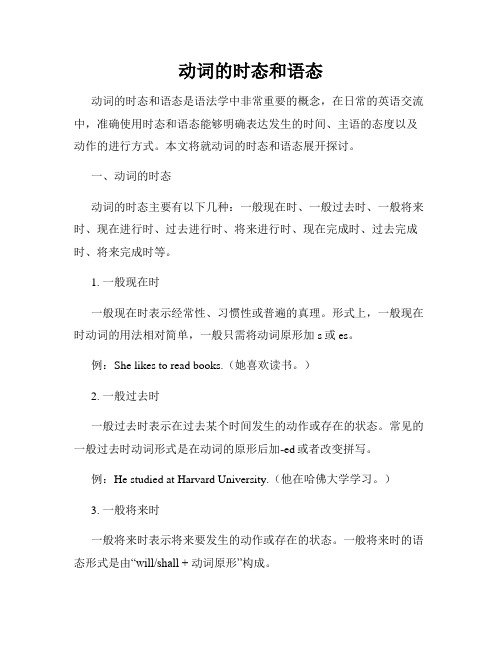
动词的时态和语态动词的时态和语态是语法学中非常重要的概念,在日常的英语交流中,准确使用时态和语态能够明确表达发生的时间、主语的态度以及动作的进行方式。
本文将就动词的时态和语态展开探讨。
一、动词的时态动词的时态主要有以下几种:一般现在时、一般过去时、一般将来时、现在进行时、过去进行时、将来进行时、现在完成时、过去完成时、将来完成时等。
1. 一般现在时一般现在时表示经常性、习惯性或普遍的真理。
形式上,一般现在时动词的用法相对简单,一般只需将动词原形加s或es。
例:She likes to read books.(她喜欢读书。
)2. 一般过去时一般过去时表示在过去某个时间发生的动作或存在的状态。
常见的一般过去时动词形式是在动词的原形后加-ed或者改变拼写。
例:He studied at Harvard University.(他在哈佛大学学习。
)3. 一般将来时一般将来时表示将来要发生的动作或存在的状态。
一般将来时的语态形式是由“will/shall + 动词原形”构成。
例:I will go to the park tomorrow.(明天我将去公园。
)4. 现在进行时现在进行时表示正在进行的动作。
现在进行时的时态形式是由“be 动词(am/is/are)+动词-ing形式”构成。
例:They are playing basketball now.(他们现在正在打篮球。
)5. 过去进行时过去进行时表示过去某个时间正在进行的动作。
过去进行时的时态形式是由“was/were + 动词-ing形式”构成。
例:He was studying at the library yesterday.(昨天他在图书馆学习。
)6. 将来进行时将来进行时表示将来某个时间正在进行的动作。
将来进行时的时态形式是由“will be + 动词-ing形式”构成。
例:They will be traveling to Europe next month.(他们下个月将要去欧洲旅行。
动词时态详解

动词时态详解动词时态是指动词表示的动作或状态所发生的时间。
在英语中,有多种不同的时态,每种时态都有其独特的用法和含义。
以下是对一些常见动词时态的详细解释:1. 现在时态 (Present Tense)- 一般现在时 (Simple Present): 用于表达经常性的动作、客观事实、普遍真理等。
- 现在进行时 (Present Continuous): 用于表示正在进行的动作。
- 现在完成时 (Present Perfect): 用于表示过去发生的动作与现在的关系,强调结果或经验。
- 现在完成进行时 (Present Perfect Continuous): 用于表示过去开始并一直持续到现在的动作。
2. 过去时态 (Past Tense)- 一般过去时 (Simple Past): 用于表达过去发生的动作或状态。
- 过去进行时 (Past Continuous): 用于表示过去某一时刻正在进行的动作。
- 过去完成时 (Past Perfect): 用于表示过去某一动作或状态在另一过去时间点之前发生。
- 过去完成进行时 (Past Perfect Continuous): 用于表示过去某一时间点之前已开始并持续到另一时间点的动作。
3. 将来时态 (Future Tense)- 一般将来时(Simple Future): 用于表示将来发生的动作或状态。
- 将来进行时 (Future Continuous): 用于表示将来某一时刻正在进行的动作。
- 将来完成时 (Future Perfect): 用于表示将来某一时间点之前已经完成的动作。
- 将来完成进行时 (Future Perfect Continuous): 用于表示将来某一时间点之前已开始并持续到另一时间点的动作。
以上是关于常见动词时态的简要说明。
对于每种时态,还有其他细节和规则需要进一步了解和掌握。
在使用动词时态时,确保根据具体语境和需要选择合适的时态,以便准确地表达你的意思。
常见的动词时态

常见的动词时态现代汉语中,动词时态包括了一般现在时、一般过去时、一般将来时以及现在进行时等多种形式。
在日常交流中,人们常常使用这些动词时态来准确地表达出事物的状态、发展趋势以及时间关系等。
下面将详细介绍常见的动词时态及其使用。
一、一般现在时一般现在时是描述现在或普遍存在的状态或情况。
一般现在时最常用的句型是主语+谓语动词。
例如:1. He studies English every day. (他每天学习英语。
)2. The sun rises in the east. (太阳从东方升起。
)二、一般过去时一般过去时用于描述过去已经发生或完成的动作或状态。
一般过去时的句型是主语+谓语动词的过去式。
例如:1. She lived in London for five years. (她在伦敦住了五年。
)2. They played soccer yesterday. (他们昨天踢足球。
)三、一般将来时一般将来时用于表示将来发生或完成的动作或状态。
一般将来时的句型是主语+will+谓语动词的原形。
例如:1. I will call you tomorrow. (我明天会给你打电话。
)2. They will arrive at six o'clock. (他们会在六点到达。
)四、现在进行时现在进行时用于描述目前正在进行的动作或状态。
现在进行时的句型是主语+be动词(am/is/are)+动词ing形式。
例如:1. He is studying in the library right now. (他现在正在图书馆学习。
)2. They are playing basketball in the park. (他们正在公园里打篮球。
)除了以上四种常见的动词时态,汉语中还有其他时态形式,如过去进行时、将来进行时、过去将来时等。
这些时态在语法上较为复杂,使用频率也相对较低,因此在日常交流中较少使用,不在本文的范围内进行详细介绍。
初中英语动词的时态
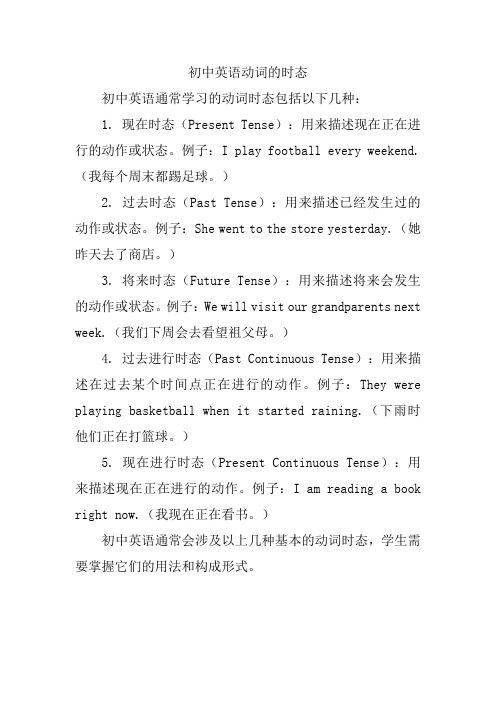
初中英语动词的时态
初中英语通常学习的动词时态包括以下几种:
1. 现在时态(Present Tense):用来描述现在正在进行的动作或状态。
例子:I play football every weekend.(我每个周末都踢足球。
)
2. 过去时态(Past Tense):用来描述已经发生过的动作或状态。
例子:She went to the store yesterday.(她昨天去了商店。
)
3. 将来时态(Future Tense):用来描述将来会发生的动作或状态。
例子:We will visit our grandparents next week.(我们下周会去看望祖父母。
)
4. 过去进行时态(Past Continuous Tense):用来描述在过去某个时间点正在进行的动作。
例子:They were playing basketball when it started raining.(下雨时他们正在打篮球。
)
5. 现在进行时态(Present Continuous Tense):用来描述现在正在进行的动作。
例子:I am reading a book right now.(我现在正在看书。
)
初中英语通常会涉及以上几种基本的动词时态,学生需要掌握它们的用法和构成形式。
英语动词的时态讲解
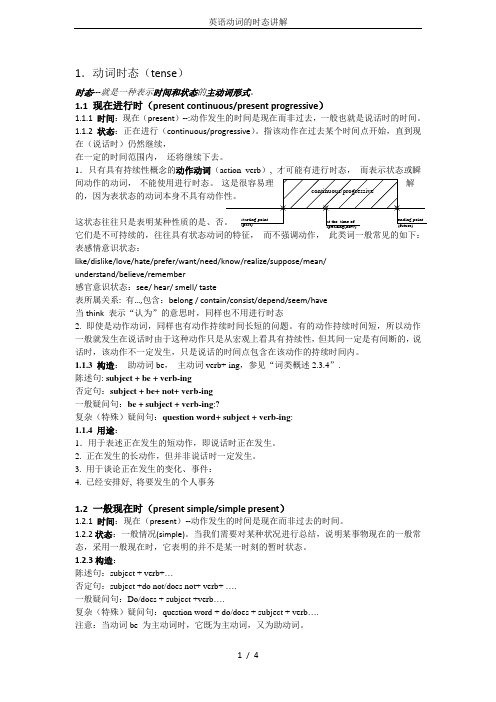
1.动词时态(tense )时态---就是一种表示时间和状态的主动词形式。
1.1 现在进行时(present continuous/present progressive )1.1.1 时间:现在(present )--:动作发生的时间是现在而非过去,一般也就是说话时的时间。
1.1.2 状态:正在进行(continuous/progressive )。
指该动作在过去某个时间点开始,直到现在(说话时)仍然继续,在一定的时间范围内, 还将继续下去。
1.只有具有持续性概念的动作动词(action verb ), 才可能有进行时态, 而表示状态或瞬间动作的动词, 不能使用进行时态。
它们是不可持续的,往往具有状态动词的特征, 而不强调动作, 此类词一般常见的如下: 表感情意识状态:like/dislike/love/hate/prefer/want/need/know/realize/suppose/mean/understand/believe/remember感官意识状态:see/ hear/ smell/ taste表所属关系: 有…,包含:belong / contain/consist/depend/seem/have当think 表示“认为”的意思时,同样也不用进行时态2. 即使是动作动词,同样也有动作持续时间长短的问题。
有的动作持续时间短,所以动作一般就发生在说话时由于这种动作只是从宏观上看具有持续性,但其间一定是有间断的,说话时,该动作不一定发生,只是说话的时间点包含在该动作的持续时间内。
1.1.3 构造: 助动词be , 主动词verb+ ing ,参见“词类概述2.3.4”.陈述句: subject + be + verb-ing否定句:subject + be+ not+ verb-ing一般疑问句:be + subject + verb-ing :?复杂(特殊)疑问句:question word+ subject + verb-ing :1.1.4 用途:1.用于表述正在发生的短动作,即说话时正在发生。
动词在不同时态的变化规则

动词在不同时态的变化规则1.过去时用ed,但是这个是规则变化的比如结尾是y的词,要变y为i加ed;结尾是d的直接加d;还有一种是不规则变化。
2.现在进行时和过去进行时加ing,句型是is/are+ing was/were+ing。
3.一般现在时三单加s或者es(结尾是O,x等)4.将来时 have/has +do扩展资料英语动词分类(1)实义动词可以具体地表示动作、行为、存在、心理活动等。
例如:表示动作行为的实义动词:说(say)、看(see)、听(listen)、笑(laugh)、吃(eat)、喝(drink)、走(walk)、跑(run)、飞(fly)、学习(study)等等。
表示状态(存在、发展、变化、消失)的实义动词:发生(happen)、存在(exist)、死亡(die)、有(have)、等于(equal)、扩大(expand)、生长(grow)等等。
表示心理活动的实义动词:喜爱(love)、憎恨(hate)、想念(miss)、害怕(fear)、希望(hope)、担心(worry)、觉得(think)、考虑(consider)等等。
表示趋向的实义动词(趋向动词):来(come)、去(go)、停留(stay)、离开(leave)、到达(arrive)等等。
(2)助动词可以分为情态助动词、基本助动词和半助动词。
基本助动词只有三个:be,do,have。
它们在句子中没有语义,只有语法作用,协助构成进行体,完成体,被动态,否定句,疑问句等。
例如:He has made a plan. 他已经订了计划。
情态动词,也称为能愿动词,表达主语做某事的可能、意愿或者必要。
其包括能/能够(can)、会(can/will)、该/应该/应当(shall/should)、或许(may/might)、必须(must)、需要(need)、敢于(dare)等等。
情态动词以实义动词的原型形式作为补语。
半助动词,在功能上介于主动词和助动词之间的一类结构。
初中动词的时态与语态
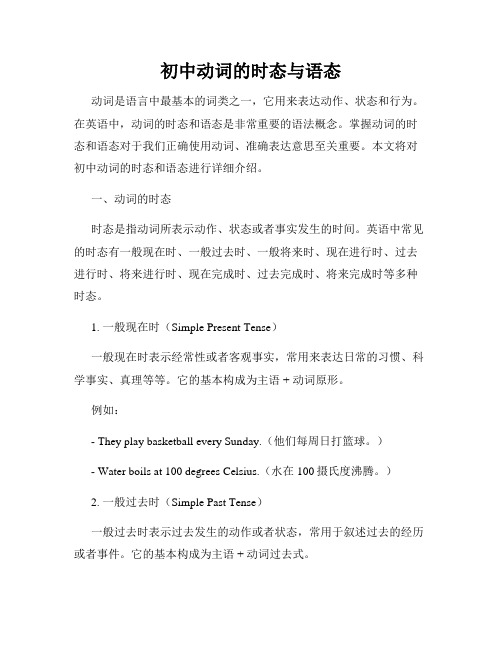
初中动词的时态与语态动词是语言中最基本的词类之一,它用来表达动作、状态和行为。
在英语中,动词的时态和语态是非常重要的语法概念。
掌握动词的时态和语态对于我们正确使用动词、准确表达意思至关重要。
本文将对初中动词的时态和语态进行详细介绍。
一、动词的时态时态是指动词所表示动作、状态或者事实发生的时间。
英语中常见的时态有一般现在时、一般过去时、一般将来时、现在进行时、过去进行时、将来进行时、现在完成时、过去完成时、将来完成时等多种时态。
1. 一般现在时(Simple Present Tense)一般现在时表示经常性或者客观事实,常用来表达日常的习惯、科学事实、真理等等。
它的基本构成为主语 + 动词原形。
例如:- They play basketball every Sunday.(他们每周日打篮球。
)- Water boils at 100 degrees Celsius.(水在100摄氏度沸腾。
)2. 一般过去时(Simple Past Tense)一般过去时表示过去发生的动作或者状态,常用于叙述过去的经历或者事件。
它的基本构成为主语 + 动词过去式。
例如:- I visited my grandparents last weekend.(我上个周末去看望了我的祖父母。
)- She didn't go to school yesterday.(她昨天没有去上学。
)3. 一般将来时(Simple Future Tense)一般将来时表示将来要发生的动作或者状态,常用于表达计划、打算、预测等等。
它的基本构成为主语 + will + 动词原形。
例如:- We will have a party next Friday.(我们下周五要举办一个聚会。
)- She won't come to the meeting tomorrow.(她明天不会来参加会议。
)4. 现在进行时(Present Continuous Tense)现在进行时表示正在进行的动作,通常用于描述当前正在发生的事情。
常见动词的时态变化

常见动词的时态变化时态是语法中的重要概念,用来表示动作或状态发生的时间。
在英语中,动词的时态变化是根据动作的不同时间点来确定的。
在本文中,我们将讨论一些常见动词的时态变化规则。
一、一般现在时(Simple Present Tense)一般现在时用于表示经常性、习惯性的动作,以及客观真理或科学事实。
一般现在时的肯定句基本结构为主语+动词原形。
例如:1. I eat an apple every day.(我每天吃一个苹果。
)2. She works in a hospital.(她在医院工作。
)3. The sun rises in the east.(太阳从东方升起。
)否定句结构为主语+do/does not+动词原形。
例如:1. I do not eat meat.(我不吃肉。
)2. He does not play tennis.(他不打网球。
)一般现在时疑问句结构为Do/Does+主语+动词原形?例如:1. Do you like swimming?(你喜欢游泳吗?)2. Does she speak English?(她会说英语吗?)二、一般过去时(Simple Past Tense)一般过去时用于表示过去发生的动作或状态。
一般过去时的肯定句基本结构为主语+动词过去式。
例如:1. He played football yesterday.(他昨天踢足球。
)2. We went to the beach last summer.(我们去年夏天去了海滩。
)否定句结构为主语+did not+动词原形。
例如:1. I did not finish my homework.(我没完成我的作业。
)2. She did not watch the movie.(她没看这部电影。
)一般过去时疑问句结构为Did+主语+动词原形?例如:1. Did you see him yesterday?(你昨天见到他了吗?)2. Did they go shopping together?(他们一起去购物了吗?)三、一般将来时(Simple Future Tense)一般将来时用于表示将来发生的动作或状态。
动词的时态变化
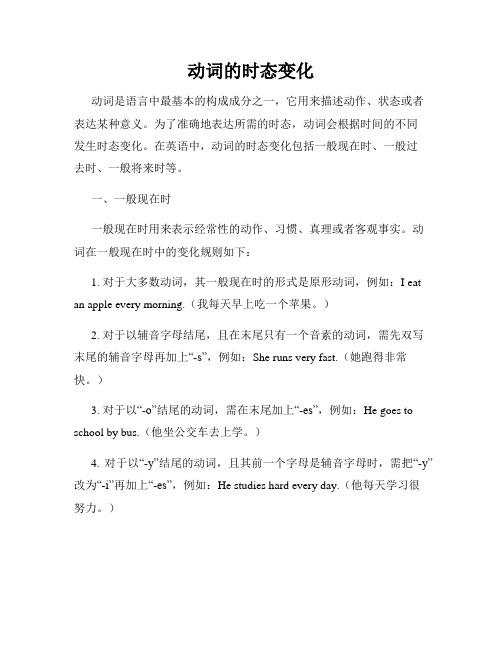
动词的时态变化动词是语言中最基本的构成成分之一,它用来描述动作、状态或者表达某种意义。
为了准确地表达所需的时态,动词会根据时间的不同发生时态变化。
在英语中,动词的时态变化包括一般现在时、一般过去时、一般将来时等。
一、一般现在时一般现在时用来表示经常性的动作、习惯、真理或者客观事实。
动词在一般现在时中的变化规则如下:1. 对于大多数动词,其一般现在时的形式是原形动词,例如:I eat an apple every morning.(我每天早上吃一个苹果。
)2. 对于以辅音字母结尾,且在末尾只有一个音素的动词,需先双写末尾的辅音字母再加上“-s”,例如:She runs very fast.(她跑得非常快。
)3. 对于以“-o”结尾的动词,需在末尾加上“-es”,例如:He goes to school by bus.(他坐公交车去上学。
)4. 对于以“-y”结尾的动词,且其前一个字母是辅音字母时,需把“-y”改为“-i”再加上“-es”,例如:He studies hard every day.(他每天学习很努力。
)5. 对于以“-y”结尾的动词,且其前一个字母是元音字母时,只需在末尾加上“-s”,例如:I play tennis with my friends on weekends.(我周末和我的朋友们打网球。
)二、一般过去时一般过去时用来表示过去发生的动作或状态。
动词在一般过去时中的变化规则如下:1. 对于大多数动词,需要在原形动词的末尾加上“-ed”,例如:She studied English last night.(昨晚她学习了英语。
)2. 对于以“-e”结尾的动词,只需在末尾加上“-d”,例如:I lived in London for two years.(我在伦敦住了两年。
)3. 对于以辅音字母结尾,且在末尾只有一个音素的重读闭音节动词,需先双写末尾的辅音字母再加上“-ed”,例如:He stopped the car suddenly.(他突然停下了车。
动词的时态和语态
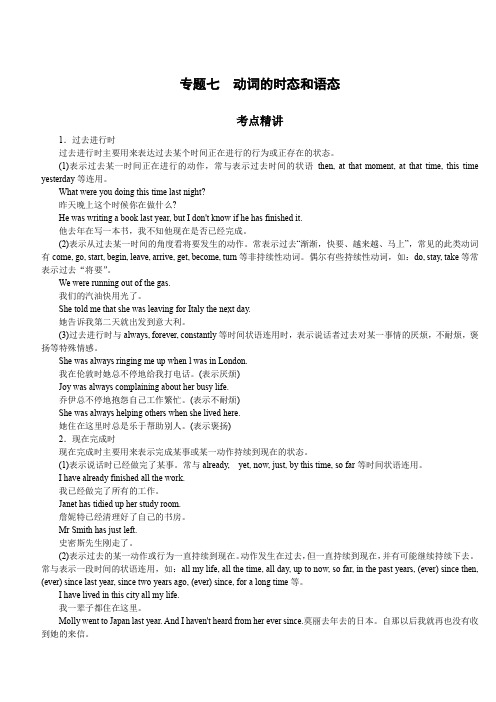
专题七动词的时态和语态考点精讲1.过去进行时过去进行时主要用来表达过去某个时间正在进行的行为或正存在的状态。
(1)表示过去某一时间正在进行的动作,常与表示过去时间的状语then, at that moment, at that time, this time yesterday等连用。
What were you doing this time last night?昨天晚上这个时候你在做什么?He was writing a book last year, but I don't know if he has finished it.他去年在写一本书,我不知他现在是否已经完成。
(2)表示从过去某一时间的角度看将要发生的动作。
常表示过去“渐渐,快要、越来越、马上”,常见的此类动词有come, go, start, begin, leave, arrive, get, become, turn等非持续性动词。
偶尔有些持续性动词,如:do, stay, take等常表示过去“将要”。
We were running out of the gas.我们的汽油快用光了。
She told me that she was leaving for Italy the next day.她告诉我第二天就出发到意大利。
(3)过去进行时与always, forever, constantly等时间状语连用时,表示说话者过去对某一事情的厌烦,不耐烦,褒扬等特殊情感。
She was always ringing me up when l was in London.我在伦敦时她总不停地给我打电话。
(表示厌烦)Joy was always complaining about her busy life.乔伊总不停地抱怨自己工作繁忙。
(表示不耐烦)She was always helping others when she lived here.她住在这里时总是乐于帮助别人。
常见动词的用法与时态

常见动词的用法与时态动词是语言中最基本、最重要的词类之一,用来表示动作、状态、感觉等。
在英语中,动词的时态和用法是学习的重点和难点之一。
本文将介绍常见动词的用法和时态,希望能够帮助读者更好地理解和运用这些动词。
一、一般现在时(Simple Present)一般现在时表示经常性的动作、客观事实和存在状态。
常见动词的用法如下:1. 动作动词:如work(工作)、read(阅读)、play(玩耍)等。
例如:- I work in an office.(我在一个办公室工作。
)- She plays the piano every day.(她每天都弹钢琴。
)2. 能力和喜好动词:如can(能够)、like(喜欢)、enjoy(享受)等。
例如:- He can speak three languages.(他能说三种语言。
)- They enjoy playing basketball.(他们喜欢打篮球。
)3. 状态动词:如be(是)、seem(似乎)、appear(出现)等。
例如:- I am a student.(我是一名学生。
)- She seems happy.(她看起来很开心。
)二、一般过去时(Simple Past)一般过去时表示过去发生的动作或存在的状态。
一般过去时的动词形式为动词过去式。
常见动词的用法如下:1. 动作动词:如worked(工作过)、read(阅读过)、played(玩耍过)等。
例如:- I worked in an office last year.(去年我在一个办公室工作。
)- She played the piano yesterday.(昨天她弹钢琴。
)2. 能力和喜好动词:如could(能够)、liked(喜欢过)、enjoyed (享受过)等。
例如:- He could swim when he was five.(他五岁时就会游泳了。
)- They enjoyed playing basketball when they were young.(他们年轻时喜欢打篮球。
动词的四种时态

动词的四种时态动词的四种时态 时态是⼀种动词形式,不同的时态⽤以表⽰不同的时间与⽅式。
它是表⽰⾏为、动作、状态在各种时间条件下的动词形式,在英语中有16种时态。
以下是⼩编为⼤家整理的动词的四种时态相关内容,仅供参考,希望能够帮助⼤家。
动词的四种时态1 (1)⼀般现在时: ⼀般现在时的构成 1. be动词:主语+be(am, is, are)+其它。
如: I am a boy. 我是⼀个男孩。
2. ⾏为动词:主语+⾏为动词(+其它)。
如: We study English. 我们学习英语。
当主语为第三⼈称单数(he, she, it)时,要在动词后加"-s"或"-es"。
如:Mary likes Chinese.玛丽喜欢汉语。
动词+s的变化规则 1.⼀般情况下,直接加-s,如:cook-cooks, milk-milks 2.以s. x. sh. ch. o结尾,加-es,如:guess-guesses, wash-washes, watch-watches, go-goes 3.以“辅⾳字母+y”结尾,变y为i, 再加-es,如:study-studies (2)⼀般过去时: 动词过去式详解动词的过去式的构成规则有: A、规则动词 ①⼀般直接在动词的后⾯加ed:如 worked , learned , cleaned , visited ②以e结尾的动词直接加d:如 lived , danced , used ③以辅⾳字母加y结尾的动词要改y为i再加ed(此类动词较少)如 study – studied carry – carried worry – worried (注意play、stay不是辅⾳字母加y,所以不属于此类) ④双写最后⼀个字母(此类动词较少)如 stopped B、不规则动词(此类词并⽆规则,须熟记)⼩学阶段要记住以下动词的原形和过去式:sing – sang , eat – ate , see – saw , have – had , do – did , go – went , take – took , buy – bought , get – got , read – read ,fly – flew , am/is – was , are – were , say – said , leave – left , swim – swam , tell – told , draw – drew , come – came , lose – lost , find – found , drink – drank , hurt – hurt , feel – felt (3)⼀般将来时: 基本结构: ①be going to + do; ②will+ do. be going to = will I am going to go swimming tomorrow(明天). = I will go swimming tomorrow. (4)现在进⾏时: am,is,are+动词现在分词 动词现在分词详解动词的ing形式的构成规则: ①⼀般的直接在后⾯加上ing , 如doing , going , working , singing , eating ②以e 结尾的动词,要先去e再加ing ,如having , writing ③双写最后⼀个字母的(此类动词极少)有:running , swimming , sitting , getting 动词的四种时态2 ⼀般现在时 主要⽤来表⽰⼈、事物的现在状况和特点;表⽰经常或习惯性的动作,句⼦中常有often, always, from time to time 等时间状语;表⽰客观规律和永恒真理等。
谓语动词的时态
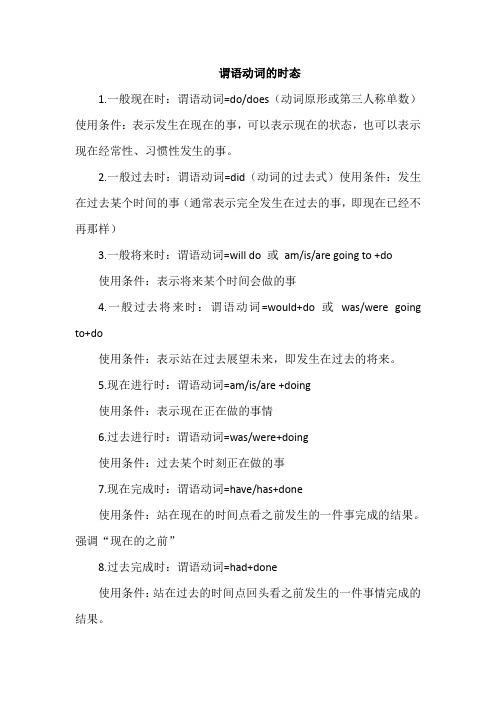
谓语动词的时态
1.一般现在时:谓语动词=do/does(动词原形或第三人称单数)使用条件:表示发生在现在的事,可以表示现在的状态,也可以表示现在经常性、习惯性发生的事。
2.一般过去时:谓语动词=did(动词的过去式)使用条件:发生在过去某个时间的事(通常表示完全发生在过去的事,即现在已经不再那样)
3.一般将来时:谓语动词=will do 或am/is/are going to +do
使用条件:表示将来某个时间会做的事
4.一般过去将来时:谓语动词=would+do 或was/were going to+do
使用条件:表示站在过去展望未来,即发生在过去的将来。
5.现在进行时:谓语动词=am/is/are +doing
使用条件:表示现在正在做的事情
6.过去进行时:谓语动词=was/were+doing
使用条件:过去某个时刻正在做的事
7.现在完成时:谓语动词=have/has+done
使用条件:站在现在的时间点看之前发生的一件事完成的结果。
强调“现在的之前”
8.过去完成时:谓语动词=had+done
使用条件:站在过去的时间点回头看之前发生的一件事情完成的结果。
动词的语态与时态

一.动词的时态和语态动词的时态英语中表示不同时间发生的动作或存在的状态,需用不同的动词形式表示,这种不同的动词形式称为时态(Tense)。
高中阶段我们需掌握十一种时态的用法。
一.一般现在时(1)表示现在经常发生或习惯性的动作或状态,常与usually, always,sometimes, every day, once a week等时间状语连用。
(2)在时间,条件状语从句中表将来的动作。
e.g. The volleyball match will be put off if it rains. (表示将来)如果下雨,排球赛将推迟。
(3)主句中的谓语动词是过去时态,但宾语从句中如果所说的是客观真理,它的谓语动词用一般现在时。
e.g. The teacher told us that the moon goes around the earth.(4)表示安排或计划好的将来动作(只限于少数几个动词:go, come, start, leave等)。
e.g. The summer holidays begin next week. 暑假从下周开始。
School begins the day after tomorrow. 后天开学。
The plane takes off at 2:00 in the afternoon. 飞机下午两点起飞。
(5)在新闻标题,小说和电影以及戏剧情节介绍中常用一般现在时。
e.g. American Ambassador leaves Beijing. 美国大使离京(新闻标题)。
二. 现在进行时(1)表示说话人说话时正在进行的动作,译成汉语“正在”。
这一用法常和表示此刻的时间状语连用,如now, at the moment, at present等。
e.g. It's raining hard now.天正在下大雨。
(2)表示现阶段而并非归眼下(此刻)正在进行着的动作。
掌握中文中的动词时态变化规则

掌握中文中的动词时态变化规则中文动词时态变化规则是学习中文语法的关键部分之一。
了解和掌握这些规则,可以帮助我们准确地表达动作发生的时间和状态。
本文将介绍中文中常见的动词时态变化规则,包括过去时、现在时和将来时。
一、过去时1. 一般过去时:表示过去某个时间发生的动作或存在的状态。
动词的过去时一般在动词词尾加上“了”字。
例如:他昨天去了北京。
我吃了早饭。
2. 过去进行时:表示过去某个时间正在进行的动作。
动词的过去进行时由“在”+动词的过去式构成。
例如:他昨天下午在写信。
我昨天晚上在看电视。
3. 过去完成时:表示过去某个时间或动作之前已经完成的动作。
动词的过去完成时由“已经”+动词的过去式构成。
例如:他已经吃过晚饭了。
我已经看完这本书了。
二、现在时1. 一般现在时:表示现在经常或习惯性发生的动作或存在的状态。
动词的一般现在时不做任何变化。
例如:他每天都去上学。
我喜欢看电影。
2. 现在进行时:表示现在正在进行的动作。
动词的现在进行时由“在”+动词的现在分词构成。
例如:他正在写作业。
我正在听音乐。
3. 现在完成时:表示过去某个时间开始,持续到现在的动作或状态。
动词的现在完成时由“已经”+动词的过去分词构成。
例如:他已经吃完晚饭了。
我已经学会了游泳。
三、将来时1. 一般将来时:表示将来某个时间要发生的动作或存在的状态。
动词的一般将来时由“会”+动词的原形构成。
例如:他明天会去上海。
我下个月会去旅行。
2. 将来进行时:表示将来某个时间正在进行的动作。
动词的将来进行时由“将要”+动词的现在分词构成。
例如:他明天下午将要去游泳。
我明天晚上将要去看电影。
3. 将来完成时:表示将来某个时间之前已经完成的动作。
动词的将来完成时由“将要”+动词的过去分词构成。
例如:他明天晚上将要吃过晚饭。
我明天将要看完这本书。
通过学习和掌握中文中的动词时态变化规则,我们可以更准确地表达动作发生的时间和状态。
希望本文对你的学习有所帮助!。
动词时态变化规则

动词时态变化规则时态是语法中一个重要的概念,它用来表示动作或状态发生的时间。
在英语中,动词时态的变化规则较为复杂,涉及到不同的时态形式和时态动词的变化。
本文将介绍一些常见的动词时态变化规则,帮助读者更好地理解和运用英语时态。
一、一般现在时(Simple Present)一般现在时用来表示经常性、习惯性或普遍性的动作或状态。
动词在第三人称单数形式下要加 -s 或 -es 结尾。
1. 主语为第一、二人称或复数形式时,动词不做任何变化。
例:I love playing basketball.例:They often go hiking on weekends.2. 主语为第三人称单数形式时,动词要加 -s 或 -es 结尾。
例:She likes to read novels.例:The dog barks at strangers.3. 特殊情况:- 动词以 -sh、-ch、-s、-x 或 -o 结尾,时态变化规则为动词 + -es。
例:He watches TV every evening.例:My father fixes the car himself.- 动词以辅音字母 + y 结尾,将 y 改为 i,加 -es。
例:She studies hard for the exam.例:He tries his best to solve the problem.二、一般过去时(Simple Past)一般过去时用来表示过去发生的动作或状态。
一般过去时的动词大部分是在动词原形末尾加 -ed。
不规则动词有自己的过去时形式。
1. 动词以辅音字母 + y 结尾,将 y 改为 i,加 -ed。
例:He studied English literature in university.例:They carried the heavy boxes into the truck.2. 动词以 -e 结尾,直接加 -d。
动词的时态口诀表

动词的时态口诀表1.一般现在时,单三-s/es,其他无变化一般过去时,动词词尾加ed一般将来时,shall/will加(动词)原形现在进行时,am/is/are加(动词)ing现在完成时,have/has加(动词)ed2.学好一般现在时,基本用法要牢记一般现在时,经常发生事客观和真理,还表将来时谓语若是实义动,形式要由主语定三单人称做主语,动词后加s/es句中若把助词用,谓语动词用原形3.一般过去时,事情发生在过去,经常反复或连续状语通常是过去,过去时间坐标志:yesterday,last,agoBe用was或were,have,has变had规则动词加ed,不规则动词须牢记变否定主语之后加didn’t,变疑问句主语之前加did还有一点不能忘,后面动词要还原动词若是was,were,变否定更简单,在它后要把not添若是要变疑问句,直接提到主语前,句尾句号变问号4.一般将来很简单Shall/will后面动原加第一人称用shallWill大家都喜欢Be going to表将来打算计划把事做5. 一般将来时,将要发生事谓语will加动原,表达多方式肯定变疑问,助词will放句首肯定变否定,not放在动中间Be going to表打算,准备计划将要干表可能,有必然,通过现象来推断6.现在进行时,表示正在发生事它的结构很简单,be加动词+ing主语变化be也变,am,is,are来体现变疑问,be前提,变否定,not紧跟be后面切记常用标志词,now,look和listen7.现在完成时,have,has加ed变疑问,have,has要前提变否定not紧跟其后面过去某时已发生,后果影响到现在Just,already离不开过去动作或状态,一直持续到现在For,since 时间段。
- 1、下载文档前请自行甄别文档内容的完整性,平台不提供额外的编辑、内容补充、找答案等附加服务。
- 2、"仅部分预览"的文档,不可在线预览部分如存在完整性等问题,可反馈申请退款(可完整预览的文档不适用该条件!)。
- 3、如文档侵犯您的权益,请联系客服反馈,我们会尽快为您处理(人工客服工作时间:9:00-18:30)。
七、动词时态(Tense)Name _____________Class_____________Number_____________【知识目标】1. 理解一般现在时、一般过去时、一般将来时、现在进行时、现在完成时2、理解过去进行时、过去完成时、过去将来时的构成【学案导航】一、一般现在时:1.概念:经常、反复发生的动作或行为及现在的某种状况。
2.时间状语:always, usually, often, sometimes, every week (day, year, month...), oncea week, on Sundays,3.基本结构:动词原形(如主语为第三人称单数,动词上要加(e)s)4.否定形式:am/is/are+not;此时态的谓语动词若为行为动词,则在其前加___________,如主语为第三人称单数,则用___________,,通常还原行为动词。
5.一般疑问句:把be动词放于句首;用助动词do提问,如主语为第三人称单数,则用does,同时,还原___________,。
6.例句:It seldom snows here.He is always ready to help others.Action___________ louder than words. (speak)注意:在__________、______________状语从句中,用一般现在时表示___________二、一般过去时:1.概念:过去某个时间里发生的动作或状态;过去习惯性、经常性的动作、行为。
2.时间状语:ago, y____________, the day before yesterday, last week(year, night, month…), in 1989, just now, at the age of 5, one day, long long ago, once upon a time, etc.3.基本结构:be动词;行为动词4.否定形式:was/were+not;在行为动词前加___________,,同时还原行为动词。
5.一般疑问句:was/were放于句首;用助动词do的过去式___________, 提问,同时___________,行为动词。
6.例句:She often came to help us in those days.I didn’t know you were so busy.三、现在进行时:1.概念:表示现阶段或说话时正在进行的动作及行为。
2.时间状语:now, at this time, these days, ___________,___________,etc.3.基本结构:___________+doing4.否定形式:am/is/are+___________+doing.5.一般疑问句:把______________________动词放于句首。
6.例句:How are you feeling today?He is doing well in his lessons.四、过去进行时:1.概念:表示过去某段时间或某一时刻正在发生或进行的行为或动作。
2.时间状语:at this time yesterday, at that time或以when引导的谓语动词是______________________的时间状语等。
3.基本结构:______________________4.否定形式:was/were + ______________________ + doing.5.一般疑问句:把was或were放于句首。
6.例句:At that time she ______________________ in a PLA unit. (work)When he came in, I ______________________a newspaper. (read)五、现在完成时:1.概念:过去发生或已经完成的动作对现在造成的影响或结果,或从过去已经开始,持续到现在的动作或状态。
2.时间状语:recently, since…for…, i n the past few years, etc.3.基本结构:______________________4.否定形式:______________________5.一般疑问句:have或has提前六、过去完成时:1.概念:以过去某个时间为标准,在此以前发生的动作或行为,或在过去某动作之前完成的行为,即“过去的过去”。
2.时间状语:before+过去的时间, by the end of last year(term, month…),etc.3.基本结构:had + done.4.否定形式:had + not + done.5.一般疑问句:______________________放于句首。
6.例句:As soon as we got to the station, the train had left.By the end of last month, we ____________________________________________ four books七、一般将来时:1.概念:表示将要发生的动作或存在的状态及打算、计划或准备做某事。
2.时间状语:tomorrow, next day(week, month, year…),s________________, in a few minutes, the day after tomorrow, etc.3.基本结构:______________________;______________________.4.否定形式:was/were + not; 在行为动词前加won’t,同时还原行为动词。
5.一般疑问句:be放于句首;will/shall提到句首。
6.例句:They ______________________ a competition with us in studies next weekend. (have)八、过去将来时:1.概念:立足于过去某一时刻,从过去看将来,常用于宾语从句中。
2.时间状语:the next day(morning, year…),the following month(week…),etc.3.基本结构:was/were/going to do;would/should + do.4.否定形式:was/were/not + going to + do; would/should + not + do.5.一般疑问句:was或were放于句首;would/should 提到句首。
6.例句:He said he ______________________ to Beijing the next day. (go)I asked who ______________________ there .(go)【做题方法】1、找出时间状语2、判断时态3、回忆改时态的结构4、选出正确答案5、复合句的时态判断:宾语从句/状语从句【同步精炼】I. Choose the best answer1. Jenny ____ with a Chinese family for two years. Now she is used to the life in China. (06)A) stays B) would stay C) is staying D) has stayed2..Nancy ______ lots of charity work in her free time since she entered college. (07)A) has done B) will do C)was doing D) is doing3. Tara is interested in Chinese culture. She ____ Chinese in Fudan University next year. (07)A) studies B) studied C). will study D) had studied4. Kevin _____________to work in his hometown after he graduated from university.(08)A. goesB. wentC. will goD. had gone5. The dirty water from the factory has caused serious pollution, ________?A) didn’t it B) hasn’t it C) won’t it D) doesn’t it6. There are more and more shop keepers doing their business in that new area, _______?A. are thereB. aren’t thereC. don’t theyD. do they7. I don’t think he will take pride in his son’s achievements, ______?A) do I B) don’t I C) will he D) won’t heII. Rewrite the following sentences as required.1. “Are you doing your homework, Tom?” Mother asked. (直接引语改为间接引语)Mother asked Tom ________ he _________ doing his homework.2 “Have you done anything to deal with the problem?” The manager asked me. (合并为一句)) The manager asked me ________ I ________ done something to deal with the problem. 3. Mary asked. Has Angela known about that? (改为宾语从句)Mary asked ________ Angle _______known about that.4. Frank asked me, “Have you ever created a comic strip?”( 宾语从句)Frank asked me whether ________ ________ ever created a comic strip.5. Kate asked: “What are you going to visit this summer holiday?”(保持句意不变)Kate asked _______I________ going to visit this summer holiday.【能力提升】I. Choose the best answer.1.By the end of last year, Ben ________ as a postman for ten years.A. has workedB. had workedC. will workD. works3. People _______ a lot of trees on the countryside by the end of last month.A. plantB. plantedC. have plantedD. had planted4. They ______ to that shopping mall many times since they moved here.A. will goB. wentC. have goneD. have been5. Mike _______as a chemistry teacher for over twenty years.A. has workedB. workedC. workingD. works6. John and Mary _______ each other pretty well before they got married.A. knewB. knowC. had knownD. have known7. The students_______ basketball when I saw them in the playground.A. playedB. was playingC. playD. were playing8. Alice ________ a volunteer for our community since she was in Grade 9.A. has beenB. wasC. had beenD. will be9. They _______ about how to protect our earth when I entered.A. will talkB. have talkedC. are talkingD. were talking10. Jane and I are good friends .We _______ each other since we came to this school.A. knewB. have knownC. had knownD. know11. My sister ________ TV when I went into her room last night.A. was watchingB. is watchingC. will watchD. watches12. Jim is a young writer. He _______ five novels so far.A. would writeB. will writeC. has writtenD. had written13. _Where _____ you _____? _ To the library. I borrowed books and returned five minutes ago.A. have … goneB. will … goC. have… beenD. will … be14. Jenny told me that she ________ an English Speech Contest the next month.A. takes part inB. is taking part inC. took part inD. would take part in15. By the end of last term, we _______ English for four years.A. have learnedB. learnedC. would learnD. had learnedII. Rewrite the following sentences as required.1. The teacher asked us, “Have you finished reading the passage?”The teacher asked us _______ we ________ finished reading the passage.2. The children are watching fish swim outside the room now. He knew. (合并为一句)He knew _______ the children________ watching fish swim outside the room then3. I haven’t seen you for a long time .The woman said to Mr Black. (合并为一句)The woman told Mr Black ________she _________ seen him for a long time .4. The monitor asked Tom…. What are you doing this time last Monday? (改为宾语从句) The monitor asked Tom what _______ ________ doing this time last Monday.5. “Have you been a secretary for about 6 years?” Jenny said to his sister. (改为间接引语) Jenny asked her sister _______ she ______ been a secretary for about 6 years.6. Could you tell me? Is Miss Li collecting the exercises in the office? (合并为一句)Could you tell me _______ Miss Li _______ collecting the exercises in the office?。
